White’s 1856 History, Gazetteer & Directory of Lincolnshire tells us that that the National School was “erected in 1855 at the cost of £580 per annum with a Church of England Foundation, the result of subscription and grants”, whilst Wilson and Ash tell us in The Bassingham Story (2003) that the school opened its doors on Monday 19th November and was built to house one hundred pupils. The Wesleyan School was built in the same year and both schools were under government inspection. White also tells us that the very first schoolmaster was Mr Jabez Jerrom who was ably assisted by his wife (later named as Mary Ann Jerrom).
By the time of the 1861 Post Office Directory of Lincolnshire the school had “a few free scholars, varying according to the amount of the subscriptions”, and eleven years later, in 1872, White informs us that the school “was attended by about 90 children of both sexes, and has a house for the teacher attached”. At this point the Master was Mr. Richard Robinson who supplemented his income by doubling-up as the Church Organist.
The 1885 Kelly’s Directory of Lincolnshire with the Port of Hull tells us that whilst under the tutelage of Mr. William Leege and his wife Annie, although the school had been built to house 100 pupils, the average attendance had dropped to just 40 children. This was the lowest on record and was almost certainly due to children being illegally employed in the fields, not that anyone was ever going to convince their farming parents otherwise, although four years later Kelly’s Directory shows that the average attendance was up marginally to 50 (although it would drop again to 41 by 1892).
In 1893 the School had formally changed status from being a National (Church) School to that of a Board School (i.e. overseen by a Board of governors and not, as incorrectly stated in some on-line sources, a Boarding School). Part of this process involved the School being expanded to incorporate the scholars at the Wesleyan Church School, thus creating a split-site with the Infants housed in the latter building. In the 1896 Kelly’s Directory of Lincolnshire and Hull the average attendance was up massively to 99 and the school was now said to have been built to house 130 children, which clearly accounted for those children now being taught across both sites.
In 1902 control was handed over to the County Council and three years later, in the 1905 edition of Kelly’s, the School was now referred to as the Public Elementary School and the average attendance continued on an upward trajectory, reaching 107, then 114 by 1909 and again in 1913. After this time, however, we can find no further indications as to attendance because from the 1919 edition of Kelly onwards we only discover the names of the Master and or Mistress. In the postcard above (c1910s) the boys are leaning against the wall and railing of the new ‘overspill’ graveyard (opened in 1902 on land given by John Brocklebank in memory of his father). The low wall and railings are still there today although they appear nowhere near as tall as they were, the level of the road having been raised in recent years. The buildings themselves appear unchanged even down to the decoration on the frontage of the near end gable. Although conjoined, the building was – and still is – two separate entities: the longer school itself on the left and “The Master’s House” at the nearest end (with the two chimneys).
In the postcard above (c1910s) the boys are leaning against the wall and railing of the new ‘overspill’ graveyard (opened in 1902 on land given by John Brocklebank in memory of his father). The low wall and railings are still there today although they appear nowhere near as tall as they were, the level of the road having been raised in recent years. The buildings themselves appear unchanged even down to the decoration on the frontage of the near end gable. Although conjoined, the building was – and still is – two separate entities: the longer school itself on the left and “The Master’s House” at the nearest end (with the two chimneys).

And another view, this time from a postcard stamped Newark, 25th August 1925 and sent to a Mrs Gregory, in Clapham. Ivy has almost completely covered the southern end of the building at this point, and the tree which makes comparative photographing so difficult these days is already well on its way to growing large. And that’s a motorbike and sidecar parked outside the new cemetery, which beats arriving in a hearse any day! 😂😂

And here is a group photograph of the “Class of 1926”! The board is very difficult to read although I can confirm that it definitely says “1926 Bassingham C. [Council] School”. The children are lined-up in front of a wall of the school. My grateful thanks go to Derek & Caroline Rossin who lent me the original postcard to scan and present for you here.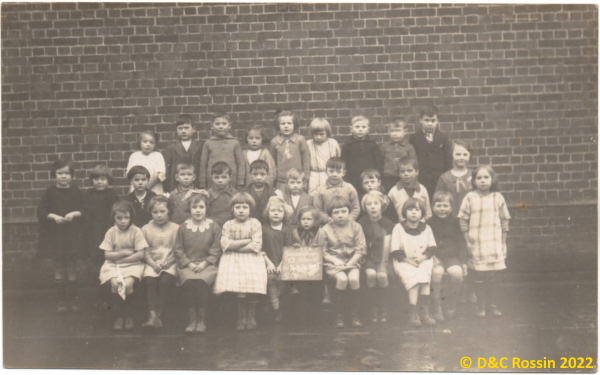 And here’s a photograph taken around 1903, again courtesy of the Rossins.
And here’s a photograph taken around 1903, again courtesy of the Rossins.
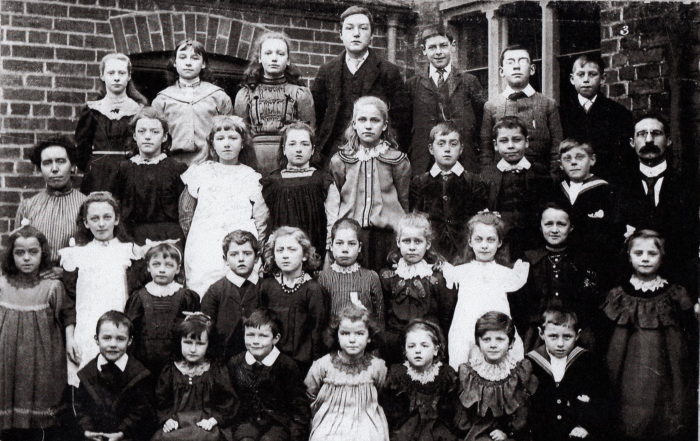
In August 2023 I finally managed to snag a copy of The Bassingham Story by Bill & Connie Wilson and Helen Ash and on page 99 there is the following photograph, one which doesn’t seem to appear anywhere else.
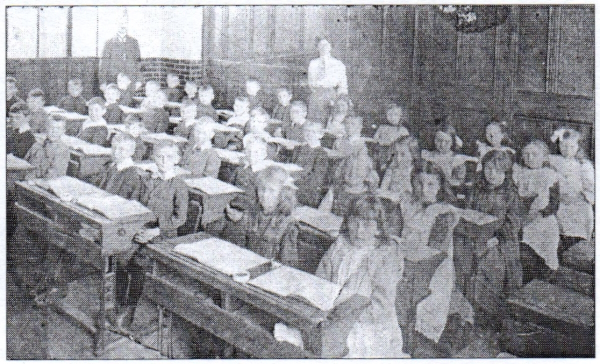
Given those dates I presume that the Mr Moulson in question must be Mr. Robert Henry Moulson (although he had been there since 1895, not 1898) and the lady his wife, Alice. Percy Moulson (and his wife Mary Ann) was at the school between 1889-91.
The School finally closed its doors in 1982 after which it was used as a church hall for a few years before being sold into private hands in 1986.
List of Schoolmasters and mistresses (where named) and their confirmed employment dates*
- 1856 – 1861: Mr. Jabez Jerrom (and Mary Ann Jerrom)
- 1861 – 1872: Mr. Richard Robinson, assisted by Mrs. Harriett Robinson (1863) and then by Mrs Henry Rogers (1868)
- 1876: Mr. Grimsley (& Mrs.)
- 1877 – Jan 1880: Mr. Albert Green
- 1881 – 1882: Mr. William Fensome, & Mrs. Emma Fensome
- 1885: Mr. William Alfred John Leege & Mrs. Annie Leege
- 1889 – 1891: Mr. Percy Moulson & Mrs. Mary Ann Moulson
- 1892: Mr. James Walmsley & Mrs Mary Moulson
- 1893 – 1894: Mr. John Morshead
- 1895 – 1905: Mr. Robert Henry Moulson, & Mrs Sarah Moulson (1901)
- 1905 – 1907: Mr. Thomas J. Rowe
- 1907 – 1924: Mr. Henry Westbrook
- 1924 – 1928: Mr. George Eric Orchard
- 1928 – 1930: Mr. George Wilfred Thompson
- 1930 – 1950: Mr. William Francis Wescombe
- 1951 – 1977: Mr. Henry John Hellier
- 1978 – 1983: Mr. Ian Roger Hirst
- 1983 – : Mr. Paul Hickman
*Dates confirmed by the various National Censuses, Trades Directories and Gazetteers, and the Bassingham School Booklet (1993 – see below).
In 1993 Bassingham School published a 30-page booklet containing a history of the school, designed to celebrate the centenary of the school, and I present it here in its entirety. My grateful thanks once more go to Derek & Caroline Rossin for supplying me with a copy which I have scanned and made available for you to download by simply clicking the cover below.
FORWARD
There have been schools founded by the Churches in Bassingham since 1855, but in 1893 the Managers agreed to form a Board School. Thus the Bassingham County Primary School had for much of its history a split site using the Church and Chapel school buildings. This booklet is prepared to celebrate the centenary of this amalgamation.
Educational provision has changed drastically over the intervening years as also has the demands of society on our schools (since the Board School was founded) and so our ancestors were taught with slates to copy write and do “sums” whereas society today uses calculators and computers.
I hope from this history old pupils will find items lost from memory in the mists of time. For newcomers to the village this booklet will show the changes and developments that have taken place over the years, which may mirror their own school days.
During the past 100 years many people have passed through the doors, some as staff and many more as pupils. The time spent here will inevitably have had some influence upon their lives and what they have done since leaving here.
I would like to thank Mrs. Hirst for researching much of the information from archival material, Mrs. Ash for typing up the script, and the people of Bassingham who came forward with pictures and memories.
Bassingham County Primary School has led the way in Community participation by initiating the “Chance-to-Share” scheme of School/Village Hall. We look forward to the continued development of the Bassingham School Complex over the next 100 years.
P. Hickman. Headmaster.
June 1993.
BASSINGHAM SCHOOL.
Head Teachers since 1893.
September 1893 – December 1894. John Morshead.
January 1895 – February 1905. Robert Henry Moulson.
March 1905 – July 1907. Thomas Rowe.
September 1907 – April 1924. Henry Westbrook.
June 1924 – May 1928. George Eric Orchard.
June 1928 – April 1930. George Wilfred Thompson.
August 1930 – August 1950. William Francis Westcombe [sic – it should be Wescombe].
January 1951 – December 1977. Henry John Hellier.
January 1978 – April 1983. Ian Roger Hirst.
September 1983 – Paul Hickman.
BASSINGHAM SCHOOL 1893 – 1993.
On September 25th, 1893, the Bassingham Board School was opened in the National School Room. One hundred and two scholars’ names were entered in the admission book on the first day with a further eleven scholars admitted the next day, making a total of one hundred and thirteen pupils in the first week. The scholars had previously attended two separate schools, the National School and the Wesleyan School. Twenty children transferred from the National School and ninety-three children carne from the Wesleyan School.
There were fifty boys and sixty-three girls being divided into the “mixed” department and the “Infants”. Sixty-nine children were in the “mixed” department and forty-four children were in the “Infants”. Mr .John Morshead was in charge of the “Mixed” department and worked in the National School Room. The “Infants” were in the hands of Miss Betsy Jane Holmes and they worked in the Wesleyan School Room.
At this time the “Mixed” department contained the following:-
- 8 desks 7 ft.6 in. long (230 cms.)
- 3 desks 8 ft. long. (250 cms.)
- Slates.
- A few books.
Each child would have had little more than one foot (38 cms.) of seat allocated to him which would have been quite a squash with six children on each of the seven foot six inch long desks and seven on the eight foot long desks! All work would have been done on the same re-usable slate, with a slate pencil which would make a horrible noise as the whole class worked.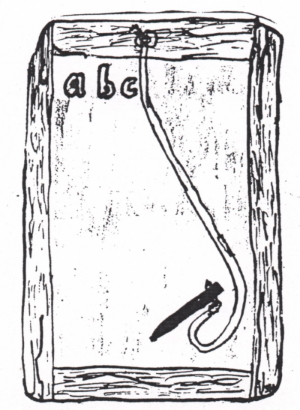 Lack of sufficient apparatus is apparent during these early days, with no materials for sewing, drawing or geography. On the 7th of January, 1894, the reading books, foolscap and pencils finally arrived, also a set of models. The Master was now in a position to give drawing lessons in preparation for the Drawing Examination which was due in April. A lady from the village, Mrs. Barnet, came into school to help the girls with their sewing whilst the boys drew.
Lack of sufficient apparatus is apparent during these early days, with no materials for sewing, drawing or geography. On the 7th of January, 1894, the reading books, foolscap and pencils finally arrived, also a set of models. The Master was now in a position to give drawing lessons in preparation for the Drawing Examination which was due in April. A lady from the village, Mrs. Barnet, came into school to help the girls with their sewing whilst the boys drew.
The main subjects taught at this time would be Recitations, Reading, Spelling, Arithmetic, Singing, English, Geography, sewing and Drawing. The first song mentioned as being taught to the children was “Catch the sunshine” on 1st December, 1883. winter days must have been dark and dreary in those days!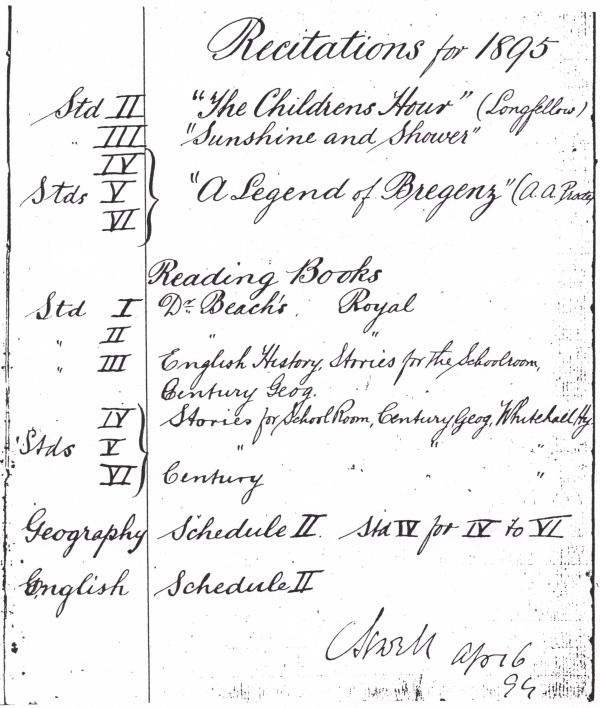 In the early days paraffin lamps would have provided any necessary lighting inside the school. Reference is made, in July 1928 to “three new hanging lamps arriving from Fitt and Sneath Ltd., Grantham.” When school re-opened on January 10th, 1938, the log book states that “electric light had been installed during the holidays.”
In the early days paraffin lamps would have provided any necessary lighting inside the school. Reference is made, in July 1928 to “three new hanging lamps arriving from Fitt and Sneath Ltd., Grantham.” When school re-opened on January 10th, 1938, the log book states that “electric light had been installed during the holidays.”
In the early nineteen twenties the King’s Empire Day Speech was listened to on a gramophone record. A wireless demonstration was given in the school on 18th February, 1926. The Armistice Day Service, broadcast from Daventry, and Lecture to schools afterwards was listened to on 11th November, 1926. Television and computer are now used in the school in preparation for the new technology of the twenty-first century.
Some form of scholarship has always been available for more able children to attend a Grammar School in nearby towns. In 1898 a scholar was successful in obtaining “Kesteven Junior Scholarship for the Electoral Division- of Bassingham and Skellingthorpe”. A Kesteven County Scholarship was gained by one lad in 1927 and he went on to attend Newark Grammar School; this paved the way for others in the following years. Lincoln Technical College is referred to in 1928. Today, with parental choice coming into operation children move onto a variety of schools, where vacancies exist, ranging from Sleaford, Grantham, Lincoln, North Hykeham as well as the Wm. Robertson School at Welbourn. In 1903 the control of the Bassingham School changed from the Local Board to the newly formed Kesteven council, hence the name changes from the Bassingham Board School to Bassingham Council School.
In 1903 the control of the Bassingham School changed from the Local Board to the newly formed Kesteven council, hence the name changes from the Bassingham Board School to Bassingham Council School.
In 1906, following an H.M.I’s recommendation, two monitors are appointed by the Managers; one in the Infant Department and one in the Upper School. These monitors were fifteen and sixteen years of age and it was their job to assist the teacher. In 1911, a monitor at the school was successful in the Pupil Teacher Admission Examination. She commenced duties as pupil Teacher at Bassingham, spending one day studying at Lincoln Girls’ High School. This marks the beginning of the pupil Teacher Centre at Bassingham School which reached its peak in 1920 when it had nine pupil teachers, by 1924 only one pupil teacher was at the school. A letter from the Managers on March 29th, 1924, says: “The Education Authority congratulate the Master on the result of the P.T’s examination. Thirty candidates sat, eight passed, out of these five were from Bassingham, none from the school failing. The Managers wish to associate themselves with the Education Authority in congratulating the Master on this result which gives a happy finish to the Pupil Teacher Centre at this school.” This also concluded the Master’s reign as he died suddenly, a month later, on Good Friday. (Mr. Westbrook)
School gardening commences during the first World War (part of the Rectory garden was allocated for this purpose – it is now part of the Nursing Home vegetable garden). Holidays were also granted for such activities as “collecting chestnuts”, “gathering rosehips”, and “gathering blackberries” as part of the war effort no doubt. Extra holidays were granted in October for potato picking.
Through the decades new ideas and approaches to subjects are tried. In the nineteen twenties swimming was introduced on the curriculum being taken daily in selected pools in the River Witham. The Senior boys had a room in the Rectory – now the Nursing Home – equipped with woodwork benches and tools, where they built a hut which they erected on the river bank so that the swimmers could undress and dress in civilised style away from peeping Toms. By 1971 swimming lessons were being given in a neighbouring school pool, namely St. Clements School at Waddington.
With better methods of communication the school begins to join in with neighbouring schools for a variety of activities, namely Music Festivals, football matches, skittleball, Inter-school sports and cross country competitions. This is a very good foundation for rural children as they will meet and compete with children of their own age with whom they will share their next school, when they transfer at eleven years of age.
The first phase of the present building was erected in 1960 and comprised one classroom, hall, and canteen.
An important milestone in the history of Bassingham School is the joint venture undertaken by the school and the village in 1972 when work commenced on the joint school/village hall project. This “Chance-to-share” scheme was new not only to Bassingham but to Lincolnshire, as it was the first of many, in fact Bassingham paved the way in this new venture. The Chance-to-share hall and social centre was officially opened by the Earl of Ancaster on Saturday 3rd March 1973. Twenty years later the school still values this strong link with the community, the complex acting as a focal point in the village. The J.M.C. {Joint Management Committee) ensures there is excellent communication and cooperation between the school and village.
The following year sees the end of Parts of Kesteven (Lincs) on the 31st March, 1974, and the beginning of Lincolnshire County Council, on 1st April.
When the new complex opened there was only one infant classroom, the remainder of the school was still some distance away, down the road. The Junior children had to trudge up and down, between sites, in all weathers for school dinners, games and P.E. lessons and school assemblies. In July 1979, the Parent/Teacher Association presented a petition to the Chairman of the Education Committee, regarding the split site school. This action, together with the increasing cost of oil, which was being used to heat two separate boilers in two separate buildings made someone, somewhere realise just how expensive and un-necessary a split site school was.
Bassingham School extension was placed at the top of the list of building programmes for 1981-2.
The school appears to have had to pay dearly for this, having been told by the Education Office that they must lose a member of staff by Christmas, 1980. The reason given was “falling numbers” – namely Bassingham School had fallen below that “Magic number” – 91 – which was then the dividing line between three and four teachers.
So Bassingham School went into the nineteen eighties with eighty six children on roll, but with the promise of the split site finally ending.
In October 1981 work commenced on the foundations, the school being completed by the end of June 1982.
The children removed their own work books from the old school to the new on 1st July and a removal van came the next day to remove the furniture whilst the children enjoyed a day-trip to Belton House, Belton Nature Trail and Adventure Playground, near Grantham.
In 1983/84 the school took part in a National Science/Technology project.
Stapleford C.E. School closed in 1984, 25 children transferred to Bassingham. The old kitchen, cooked school meals having stopped being provided in the early 1980s, was designated as the fourth classroom. However, the village wanted to keep the room and the Parish Council agreed to pay £7000 towards the cost of building a new classroom. This is the one which presently houses the Reception/Year 1 children, a much better proposition. However, it wasn’t without its -problems as one wall had to be taken down twice to meet the required building regulations. It was finally completed in January 1985.
The Headteacher took a class of older children in the Social Area, the Hall and the Community Room (old kitchen) at various times, until in 1988, a mobile classroom was provided. This was on site for 2 years but was deteriorating rapidly. Numbers continued to rise to a maximum of 148 in 1989. In January 1991 the County Council built a permanent classroom, attached to the complex. At the same time a new library was built in the largely unused inner courtyard.
In 1987 an “Environmental Area” was created in the school grounds and continues to thrive and grow. We have developed this idea by creating another “Environmental pocket” behind the village church.
In 1988 the New Education Act carne into force and teachers’ shelves started to bend under the deluge of folders that arrived!
1992 saw the school take control over its own budget under LMS (Local Management of Schools). The budget being determined by the number of children on roll – shades of the 1890s.
MEMORIES OF MY DAYS AT BASSINGHAM OLD SCHOOL.
9 a. m. promptly the school bell rang, the children formed lines in the playground and spaced themselves, army fashion, marched into the school to the piano playing the music “Impudence” (I often wondered why?)
There were three classrooms, two classes in each room. The lessons taught were Grammar, (it wasn’t termed English) Arithmetic, Mental Arithmetic, Geography, Spelling, Poetry, Needlework, Singing, etc. The teacher stood by the blackboard, the class facing the blackboard and everything written on the blackboard. To my mind, this was a helpful idea, having a photographic mind, you could remember seeing it written but it was easy to forget the spoken word.
The morning began with a prayer and finished in the afternoon with the singing of the hymn “Now the day is over.”
The Headmaster was always addressed “Sir”, never by his name and the female teachers “Miss” be they married or single!
The children were taken on nature walks to examine bird life, wild flowers, trees, cloud formation and wind direction. Slates were used, what a saving of paper, they never seemed to wear out.
If a funeral should take place at the Church across the road we were kept in the school and were quiet.
The School Inspector carne to the village with pony and trap, “woe-betide” if he caught you on the street and not at school!
Village children went home for dinner, but some had to walk two or three miles to school with their dinner packed up and some became so cold and hungry they ate their dinner before arriving, that meant no food all day and a three mile walk home at night to a hot meal!
The huge coal fires in the school were a welcome sight on a frosty morning and of course children having a long way to walk were often very wet, their clothes were put on the guard around the fire.
By Mrs. P.M. Bates.
Former pupil and long serving Member of the Governing Body.
SCHOOL ATTENDANCE.
In the early days attendance was a major issue, with potato setting, haymaking and potato picking all taking preference over education at the appropriate times. During the months of April, May, June and October the average attendance drops dramatically with less than one third of the total numbers of children at school.
At this time attendance was most important as it decided “how much annual Government Grant would be awarded to the school.” Low attendances meant low grants and so whilst Bassingham was in such a position, with two thirds of the school absent for half of the school year, little help was received financially. Many references are made to attendance and to the lack of an “attendance officer” for Bassingham.
The Attendance Officer does appear later in the story as a grand fellow who rode around in a “pony trap”. He sometimes visited the school first on his arrival in the village and sometimes not; having been “around the village houses” before arriving at the school. He had an extremely difficult task in coaxing older children away from employment in the fields and into the schoolroom. Many families would probably rely upon older children’s earnings in order to “keep the wolf from the door.”
A condition of the Bye Laws at this time was that children had to gain a “pass” at standard V before they could leave school. Many could not achieve this “pass” which in turn would entitle them to a “labour certificate”, as they were only in school for half the year, in the other half of the year they were “illegally” employed in the fields. Some children were kept at home in order to look after the house and care for younger children.
For March 1898 we find an interesting entry:- Many school photographs taken at the turn of the century would have been mainly of those children who had never been absent from School during the preceding twelve months, an added incentive to attend regularly! This was probably so at Bassingham where school photographs taken at this time show thirty one and forty three children respectively, when there were about one hundred and twenty children on roll.
Many school photographs taken at the turn of the century would have been mainly of those children who had never been absent from School during the preceding twelve months, an added incentive to attend regularly! This was probably so at Bassingham where school photographs taken at this time show thirty one and forty three children respectively, when there were about one hundred and twenty children on roll.
Lack of any form of waterproof covering must also have been a factor in “non-attendance“. In these early days prior to the “wellington boot” and the “anorak” or “mackintosh” many children would get soaked through on a journey to school . This, together with lack of drying facilities , only one fire in each classroom, and these only lit between the end of October and March; caused attendances to fall whenever there was a storm at school time. Bassingham School suffered its fair share of epidemics, with the school being closed for many weeks at such times. In June of 1901, 1907, 1914, 1935 and 1937 the school was closed for several weeks owing to outbreaks of measles in the village, which in those pre-inoculation days would have been a very serious illness indeed. Diphtheria and Scarlet Fever strike the village in October 1912, when the school is closed for four weeks and again in October 1920 and September 1943.
Bassingham School suffered its fair share of epidemics, with the school being closed for many weeks at such times. In June of 1901, 1907, 1914, 1935 and 1937 the school was closed for several weeks owing to outbreaks of measles in the village, which in those pre-inoculation days would have been a very serious illness indeed. Diphtheria and Scarlet Fever strike the village in October 1912, when the school is closed for four weeks and again in October 1920 and September 1943.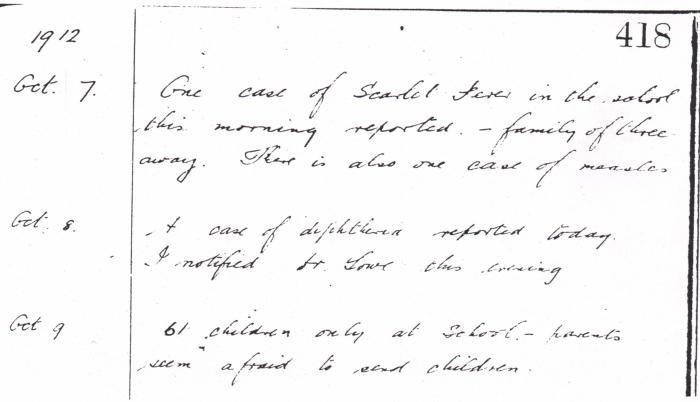 Impetigo closed the school in 1911 and 1916.
Impetigo closed the school in 1911 and 1916.
Many village events caused the closure of the school on occasional days. (The Governors were empowered to fix 6 at the annual days holiday.) The Wesleyan School Anniversary ismentioned from June 29th, 1894. This village tradition still exists to this day when the children ride around the village; today by tractor and trailer, yester-year by horse and cart. They rode in “wagons” gaily decorated with flowers, singing and collecting donations for school funds. [In the picture here the “carrier” is identified on the waggon as C.H. Tinley although his name/business does not appear in any directories leading up to 1930. John Brogan has subsequently got in touch to say, “Just been reading your page about Bassingham school. You mentioned Mr Tinley but no mention of him in directories; they had Savage’s Farm on the Carlton Road and lived in the big house that stands on its own where there is a barrow selling bits and bobs. His daughter Ruth was a very big local historian and lived her final years in Lincoln dying, I’d say, about 8 years ago in her 90s. I went to her house a few times doing research. Everything she had is now in Lincoln archives research.” [RP]
[In the picture here the “carrier” is identified on the waggon as C.H. Tinley although his name/business does not appear in any directories leading up to 1930. John Brogan has subsequently got in touch to say, “Just been reading your page about Bassingham school. You mentioned Mr Tinley but no mention of him in directories; they had Savage’s Farm on the Carlton Road and lived in the big house that stands on its own where there is a barrow selling bits and bobs. His daughter Ruth was a very big local historian and lived her final years in Lincoln dying, I’d say, about 8 years ago in her 90s. I went to her house a few times doing research. Everything she had is now in Lincoln archives research.” [RP]
School was closed on June 8th, 1894, for the “Club Feast” and again on October 14th and 15th for the “Village Feast”. On June 2nd 1898 the “Oddfellows” held their annual parade and on August 4th 1899 “Barnums” (the famous circus) at Lincoln drew many from attending school. In February 1897 the Primrose League disgraced themselves by leaving the classroom in a shameful state. The Coronation Holiday Feast on the 4th June 1911 left the school floor in a very greasy condition after the Public Tea. The Boy Scout and Girl Guides had an outing to Skegness in 1913 which reduced numbers in school. One occasion when the school did not close was on June 9th 1916 when the Correspondent requests that the school will open this Whit Monday in deference to the Prime Minister’s wish. On September 28th 1916 “an aeroplane dropped in the village at noon.” This has reduced attendance, presumably many children went to see this strange object from out of the sky.
Many National days caused the school to close for a day or an afternoon. In the early 1920’s “Empire Day” was an important event. Special lessons on the Empire were given and the children sang patriotic songs and saluted the flag of Britain. They all listened to the reproduction of the King’s speech (George V) on the gramophone record. In the afternoon a holiday was given. On January 21st 1924 a teacher at the school could not attend in the morning, she was held up at Grantham by the Railway strike!
An interesting entry for December 5th 1924 says that “attendance has been good, probably due to the fact that children staying to dinner have been supplied with a hot cup of cocoa each day.”
In 1927 the Headmaster was absent on a visit to Spittlegate School, Grantham, at the invitation of the Chief Education Officer, to study the application of wireless to the school curriculum.
May 6th, 1915 the occasion of the King’s Silver Jubilee caused the school to close for the celebrations. On September 1st, 1939 School was closed for a further ten days during which time some transformation had taken place.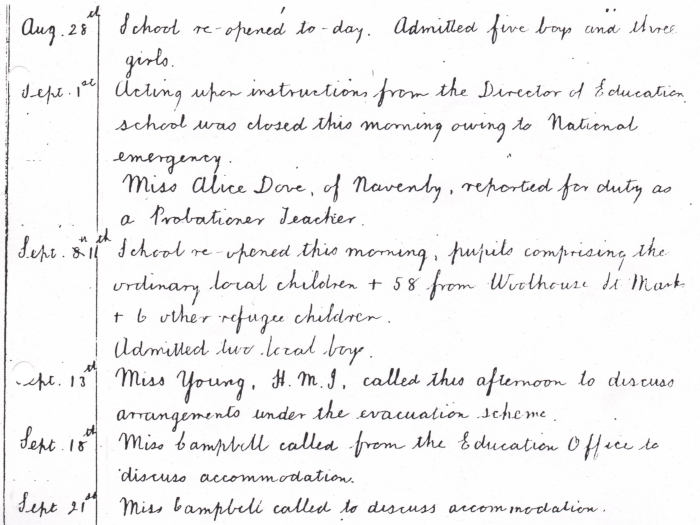 Hostilities in Europe had commenced and children from the cities were being removed to the countryside, which was considered safer for them!
Hostilities in Europe had commenced and children from the cities were being removed to the countryside, which was considered safer for them!
In June 1944 the first reference is made to a “beet singling holiday” this was previously referred to as “haymaking time.” Does this perhaps signify a change in agricultural practice ?
On November 20th 1947 the school was closed for the wedding of Princess Elizabeth and on July 11th the school had a seaside outing to Mablethorpe.
In 1951 and 1953 Potato Picking Holidays were extended for children over thirteen years of age, who were still seasonally employed by local farmers. On June 9th 1951 school was closed to enable the staff to take a party of children to the County Agricultural Show at Belton Park, Grantham. The references made to the Manager’s days for 1956 prove to be most interesting:- “The Managers approved the following closures:- Ascension Day, Methodist Anniversary, School Outing, School Sports and Test match.”
Many “Royal” events would cause the school to close. On June 22nd, 1897, school was closed for the Diamond Jubilee of Queen Victoria. On June 26th, 1902 school was closed for the Coronation of Edward VII and also for our own Queen’s Coronation on 2nd June, 1953. On the 27th June, 1958, school was closed when her Majesty the Queen visited Lincoln for the official opening of Pelham Bridge. School closed for the wedding of Princess Margaret in 1960 and Princess Anne in 1973.
General Elections, too, have closed the school on various occasions when the building was used as a Polling station. Snow, and the blocked roads that go with it, has closed the school on numerous occasions as well as exceptionally low temperatures and faulty heating systems. In 1969 and 1970 the school was closed on two occasions when the teachers withdrew their services.
Today a wide variety of school outings and visits take place to enhance the children’s learning experiences.
The fact that Bassingham has had only ten headmasters in the 100 years since the Board School first started seems quite remarkable when other members of staff came and went with great regularity. One amazing factor about the school is that, up until 1954 the school had had only two Infant Teachers – Miss Betsy Jane Holmes served the school for thirty years from 1893 when the Board school started until 1923 when failing health forced her to retire. The next Infant Teacher was Miss Lucy Eva Parker who taught the Infants from 1923 until 1954. This means only two infant teachers in 61 years.
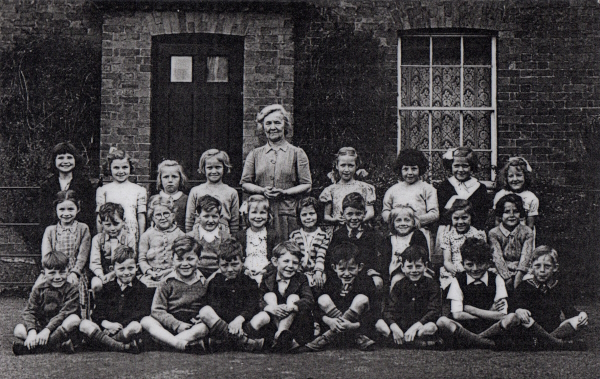
(Left to right: Back row) Monica Marshall, Valerie Woods, Maureen Baker, Mary Leadbeater, Miss Parker, Rosemary Major, Jean Priestley, Estelle Clarke, .Julia Walker
(Middle row) Hazel Shelton, Alan Taylor, Maureen Derry, Brian Broughton. Ellen Green, Hazel James, Dennis Robinson, Moira Lester, Pam Blow, Joyce Rook.
(Front row) Neville Lester, Peter Boothman, Nick Maltby, Colin Boothman, John Westbrook, Brian Kirk, Peter Taylor, Barry Mettam, John Baker.
VISITORS TO THE SCHOOL.
A regular visitor to the school, from early days, was the Clerk, who examined the registers regularly.
An annual visit was paid by the H.M.I. to inspect the children’s work on behalf of the Government. He would then award the years grant. The amount earned for 1896 was 20s 6d. (£1.02) in the “Mixed” department and 15s- (75p) in the Infant Department. The School attendance Officer is often mentioned for his appearances (or non-appearances, when needed in the early days.) On two occasions, when illness has struck the school, he arrives in his “trap” but refuses to enter the school.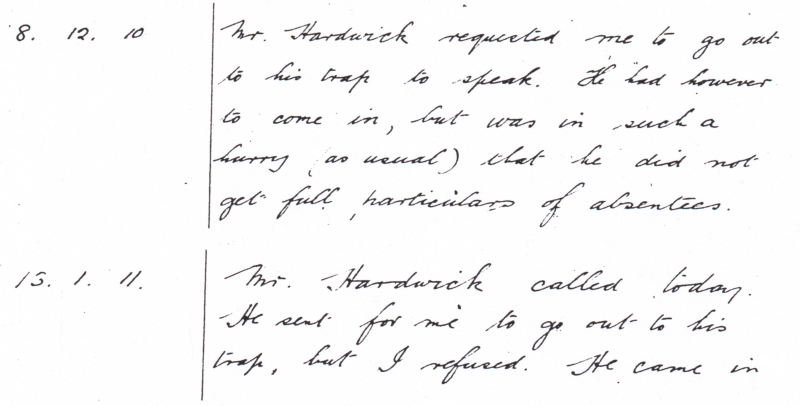 The children had impetigo at this time.
The children had impetigo at this time.
A very kind, benevolent Lady appears on the scene at this time on December 21st. 1911:- [Mrs Marfleet was wife of local landowner Charles Marfleet RP]
[Mrs Marfleet was wife of local landowner Charles Marfleet RP]
She came again in 1912.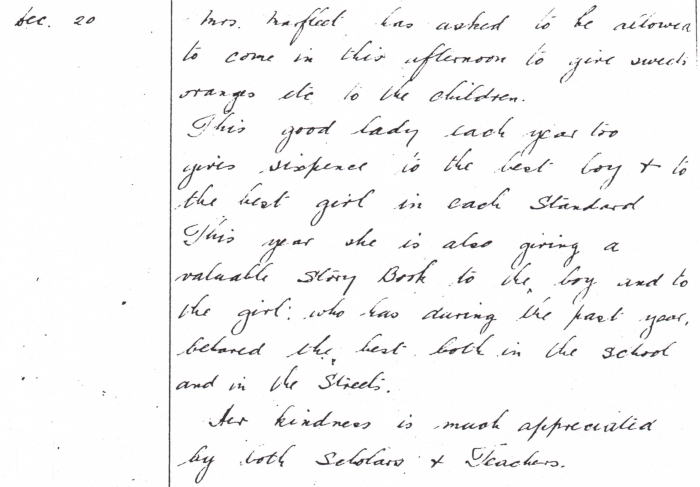 In June 1913 the School Nurse starts to visit the school. Medical Examinations commence in 1916, and the School Dentist commences visiting in March 1921.
In June 1913 the School Nurse starts to visit the school. Medical Examinations commence in 1916, and the School Dentist commences visiting in March 1921.
In January 1915 Bassingham School admitted a Belgian refugee – Alphionese Viemminex, aged seven years. The following year Miss Bertha Adlem, a teacher at the school, leaves to reside in Brisbane, Australia!
Other visitors to the school include, in 1916, a speaker from the Band of Hope Union, who gave a lecture on the “evil effects of alcohol” and in 1917 the National W.S. Association caused the school to be closed whilst they gave a demonstration on “Food Economy and Fruit Preserving”.
1924 saw the arrival of a series of books for the Bassingham Centre of the County Lending Library, which opened at the school in the evenings. This commenced with forty-five members.
1925 saw a visit from the Assistant Secretary of the Education Committee to discuss the possibility of obtaining some land for school gardens. He again visited, the same year, and gave his formal consent to the use of selected swimming “pools” in the River Witham, the Head Teacher and Assistant Mistress to be allowed to conduct parties of boys and girls to the river at 3.45 p.m. daily for instruction in swimming, weather permitting. That was in the days before insecticides and pesticides polluted the said waterway!
On January 14th, 1935, the National Milk Scheme commenced in Bassingham School and fifty children were supplied. These being the children whose parents requested that they should have the milk and were prepared to pay. It was not until September 9th, 1946, that “free milk” was delivered to the school at the rate of one hundred and ten bottles per day. 1947 saw the opening of the School canteen, with the Infant Section commencing on 23rd April and the remainder of the school the next day. Between May 1931 and November 1935 the school starts receiving pupils over the age of eleven years from Aubourn and Carlton le Moorland. These children were issued with bicycles as were children travelling tram Norton Disney and Stapleford.
The Hadow Report on the “Education of the Adolescent” stated that Secondary Education was to be a normal course for all children between the ages of eleven and fourteen. There would be a complete break in school life between the Primary and Post Primary school, the post primary school would have a fresh organisation and curriculum with a “realistic” or practical trend in the last two years. The work of re-organisation went ahead slowly and by 1938, sixty-five percent of pupils over the age of eleven were in re-organised schools. Bassingham was a Primary school for the children of Bassingham and a Post Primary School for children from Bassingham, Carlton le Moorland, Aubourn, Stapleford and Norton Disney. This was hardly the “complete break in school life” for Bassingham children. This continued until 1960 when the Wm. Robertson School at Welbourn opened for all children over eleven years of age.
The Infant class, which was housed in the Methodist Schoolroom when the Board school first opened in 1893, moved into the National Schoolroom to join the rest of the school just after the turn of the century, when numbers were low enough to cater for them. In 1932 when Bassingham was created an “All Standard School” the infants once again found themselves back in the Wesleyan Schoolroom, where they remained until 1960. At the beginning of the nineteen fifties County Advisors commence visiting the school, advising on the various subjects on the curriculum ranging from Horticulture to Needlework. H.M.I’s continue to visit the school and on the 15th and 16th November, 1954, the school underwent a “full inspection” by three H.M.I’s. At this General Inspection of the school, it was noted, in the report made, that the girls’ playground was not good, having a brick surface, and that the whole school was “an unlovely building”!
Children who were not selected for Grammar School education transferred at fourteen years of age to the H.O.R.S.A. centre at Leadenham. The senior pupils had no facilities for instructions in handicraft or housecraft, they did follow a graded course in bookcraft for the boys, and needlework for the girls. Following this inspection, in January 1956 girls commenced housecraft lessons at Potterhanworth C of E School! On the first visit the bus apparently got stuck in a snowdrift! The playgrounds were re-surfaced on September 17th 1956.
Other visitors to the school include, in 1952, the National savings Committee, who showed films to the children in the British Legion Hall. (Now the Carpet Warehouse.) In 1953 a lecturer from the Schools’ Lecturing association spoke on “Travelling in India”. A traffic sergeant from Lincoln talked to the children on road safety and inspected their bicycles in 1955 and again in 1957. In September 1957 Miss Richards starts working at Bassingham as a peripatetic needlework teacher. In December 1958 the children saw a film show “The Village of Bassingham”. (This film is now available on video.)
The nineteen sixties saw the beginning of skin tests for T.B. vaccination carried out by the school Doctor. In July 1960 the Cycle Proficiency Examinations started. In December 1960 work commenced on converting the old vault type lavatories in the main school yard into water closets. New hand-basins and electric water heaters were installed in the two cloakrooms in the school.
An Education Milestone for the over elevens was recorded in February 1961 when the new Secondary Modern School at Welbourn was opened:- In 1962 students from the Bishop Grosseteste College commence visiting the school on a one day a week basis for three weeks. We still regularly have students from the college, undertaking their teaching practices.
In 1962 students from the Bishop Grosseteste College commence visiting the school on a one day a week basis for three weeks. We still regularly have students from the college, undertaking their teaching practices.
In May 1965 a Coffee evening and concert was held and the same year the Theatre Centre Ltd. carne to the school and performed plays for the children. This was the first of many annual visits.
In March 1967 work commenced on the connection of the New Premises to the main sewerage system.
On 29th February 1968 the Parent-Teacher Association was formed, a valuable asset to any school and whose help and assistance is greatly appreciated by the school and village alike, as they don’t just raise money for the school but also put on a variety of social functions for the community. since 1990, in conjunction with the school children, they have held a Children’s Charity week to support local causes.
In 1972 the Police showed a film “Never go with strangers” and in 1975 “Safety on the Shore”. Today the village has two “Community Policemen” who regularly drop in to liaise closely with the staff and children.
1977 saw the Queen’s Silver Jubilee Celebrations in full swing. Bassingham was no exception when a Jubilee Exhibition was held in the school on June 1st. On June 2nd the Rev. G. Owen presented Jubilee Mugs to children at the school.
In 1978 the curriculum was widened even more when groups of children from the top class were taken on camping and environmental study holidays by the Headmaster. Villages in the Yorkshire Dales were studied and compared with Lincolnshire villages.
Various people visited the school to talk to the children on various topics ranging from aspects of the Police Force to a Golden Eagle handler.
On the 13th October, 1982, the school extension was officially opened by Lady Beatrice Plowden. This followed a Service of Dedication and a performance of “Jonah-man-Jazz” by the scholars
of the school.
From 1988 the older children have had the opportunity to partake in a P.G.L. adventure week during which the children are constantly challenged through the vigorous programme of physical activities and new situations. They discover new sports and learn new skills. More important they learn valuable lessons about themselves and their friends. The visits offer a significant contribution towards each child’s personal and social development (the main reason for embarking on such a venture).
In December 1990 the new school library was officially opened by the well known author Michael Hardcastle.
METHODS OF COMMUNICATION.
Methods of communication vary through the decades, with the telegram being the main method until 1928 when the first reference to a ‘phone is made. This was an outgoing call to the Education Office, so presumably this would have been made from the public telephone. In fact the telephone was not installed in the school until 1967.
Cars and buses begin to emerge in the 1930’s with such references as:-

 The run-a-way bus of Bassingham caused much damage to the school wall in 1935.
The run-a-way bus of Bassingham caused much damage to the school wall in 1935.
The railway was used for the removal of desks. When the school started receiving extra children over the age of eleven years, eight dual desks were transferred to Bassingham from Stamford C of E. School by way of the railway to Harmston.
November 1984. The school bus driver was reported for speeding. A local councillor had followed her at over 70 mph along the country roads.
SPORT.
The school has had varying degrees of success over the years in the District Sports competitions, winning the skittleball, football and athletic tournaments on several occasions. The footballers won their competition 4 years running from 1989-1992. More noteworthy were the Cricket team, who in July 1984, after a series of knock out rounds, represented the County at the Esso/Lords Taverners festival at Grantham.
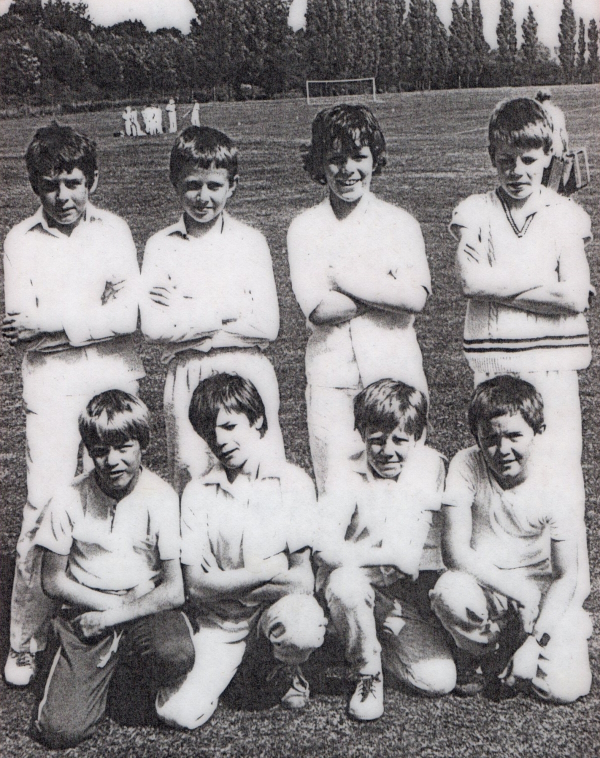
MR WESTWOOD AND THE SCHOOL CRICKET TEAM 1909

MR. ORCHARD AND THE SCHOOL FOOTBALL TEAM 1925/6.
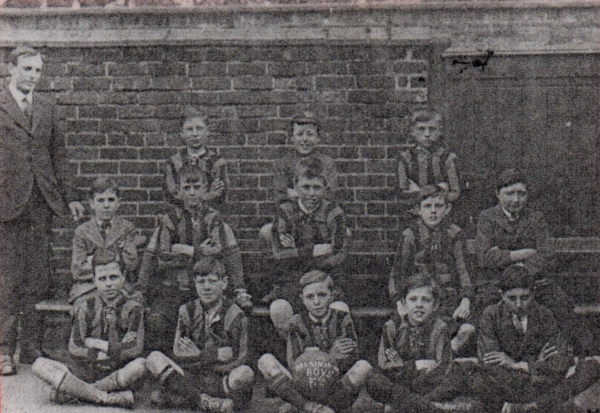
ANECDOTES.
- Nov. 15th. 1895. Poor attendance in upper classes, children away beating at Norton.
- 1896. H.M.I. on his visit recommended:- “A lock on the door separating the Boys’ and Girls’ Playgrounds”.
- 1897. H.M.I. notices:- “The stench in the Boys’ offices is most dangerous. The door between the Boys’ and Girls’ offices (toilets) is open today as it was on the occasion of the visit of my staff in November last”.
- 1897. Part of the plastering of the middle room fell during school hours amongst the children.
- 1897. Several cases of illegal employment of children this week. Some children are gleaning and others brambling.
- 1898.H.M.I. suggests:- “The course shingle of the playground should be covered with some finer material”. “The classroom fireplace should have a guard”.
- 1898. Several children away today bush-beating for Lord St. Vincent.
- January 8th, 1901. Whilst playing, this morning an Infant was accidentally knocked down by another Infant, which resulted in her leg being broken.
- 1906. For eating gooseberries in school – 2 strokes.
- 1909. A girl swallowed a pin this afternoon during needlework. Upon the advice of Canon Matthews I sent her to the Doctor.
- 1911. For eating nuts in school – 2 strokes.
- 1912-1915. For getting under Church Bridge and looking up girls’ clothes (11 boys aged 10,11 and 12 years) 2 strokes each: 1 on each hand.
- 1918. 3 hungry lads aged 10 years punished for stealing dinners 2 strokes each.
- 1924. 11, 12, 13 and 14 year old boys misusing offices – standing on seats – 2 strokes each.
- Feb. 24th, 1926. An 11 year old girl received a poke in the eye from the stick of another girl when playing at “whip top” during the dinner hour today.
- Oct. 12th. 1926. An infant boy got a bead stuck up his nostril. I sent him to Dr. Johnson who successfully removed it.
- Sept. 7th. A window in the boy’s porch broken due to a boy attempting to kill a wasp on it.
- March 1960. Thurlby parents boycott the Infant School because of bad sanitary conditions in the Methodist Chapel Schoolroom (Dysentery was rife at the time) This led to the building of the infant classroom, hall and canteen on the Lincoln Road.
- June 14th, 1984. The Social Area was used for the European elections, the school remained open. The police visited us and warned us about a “bomb scare” at a polling station, to go off
at 2.00 p.m. This was a good opportunity to hold a fire practice. - April 1986. Mr. Schofield managed to break the cross bar of one goal whilst playing football with the boys during the morning break!
- July 1987. Mrs. Bundy (teacher) was absent, badly bitten by a dog.
- February 1990. The school was broken into during the night. Various electrical items were taken and a Yucca plant!
- October 1990. Our school won the prize for the best Compost Heap – some £400 in total.
- In the late 80s. an “Environmental Area” was created in the school grounds and continues to thrive and grow. We have developed this idea by creating another “Environmental pocket” behind the village Church.
CHILDHOOD MEMORIES.
We have tried to give some ideas of interesting happenings by quoting from the log books. This only tells the official story. What follows are the recollections of four former pupils about
life at Bassingham School. (Mr. E.Taylor, Mr. A.Butler, Mrs. E.Ash (nee Hardy) and Mrs. E. Hammond (nee Walker)
Lessons.
These were very similar to todays, except they were known by different names e.g. arithmetic, composition, copy writing, nature study and scripture. Everybody did the same work at the same time. Water for painting lessons had to be fetched from the pump in the yard. Mr. Butler remembers how hard it was to write with the pens but he did enjoy flicking ink at the other boys in the class!
Classrooms.
There were three classrooms. One for the “babies” and 2 classes in each of the other two. Children stayed up to 14 years of age. The school bell summoned the children who had to line up, boys in one line and girls in another.
There were no pictures on the walls. The blackboard and easel were at the front of the class and the children sat in rows at long desks with inkwells. If you wanted to ask the teacher something you weren’t allowed to leave your seat, you had to put your hand up. If the Headmaster came into the room you all had to stand up.
Each classroom had a coal fire with a fire guard. If you wanted to go to the toilet it meant a trek across the playground, and in winter it was not unusual to have to brush the snow off first.
Many children had to walk for several miles each day, to and from school, but Mrs. Hammond and her brothers and sister had a novel approach to this problem. One would cycle for a while then leave the bike and carry on walking, one of the children would then reach the bike and repeat the operation. This relay was repeated on the way home.
There were no hot meals provided in the 20s but the children were given a cup of Horlicks and were allowed to bring soup to be warmed up on the classroom stove.
Time off.
Holidays were taken for 2 weeks in October to coincide with the potato picking. If it snowed heavily the boys were let out to help clear the road. Mr. Butler can remember it being so deep that he was walking “on top of” the hedges. When he was 12 he was given permission to drive the horse and cart to Lincoln each Friday, as the carrier had broken his leg.
Games.
Rounders, netball, football were played but for your swimming lesson it was down to the river. The River Witham was much cleaner then and there were some “lovely sandbeds”. You could dive off the banks into pits gouged out near bends in the river.
Teachers and discipline.
They all remember Mr. Westbrook as being very strict. You daren’t get up to anything. If you spoke in class or your work was untidy you got the cane. This was either a “stripe” across your hands or you had ‘t o bend down and touch your toes to receive a stroke across the bottom, usually in front of your classmates.
It didn’t stop there, if you were in trouble for something you had done in the village you still got the cane in school.
e.g. – boys snowballing the vicar’s wife.
– throwing fireworks into the Five Bells.
– tying gates together “imprisoning” a lady from Carlton who came round collecting the sewing.
As Mr. Butler said “It hurt, you didn’t misbehave again – that day!” He also remembers being naughty with Mr. Orchard (Headmaster) and being sent out to clean his motor bike. (His wife
then came out and gave him 6d.)
Mrs. Hammond remembers Mrs. Westcombe [sic] (Teacher) regularly putting her cold hands down children’s backs. Mr. Hellier (Headteacher) was the only teacher she could remember who had a nickname “Rhubarb”, because he was so tall.

 BACK HOME
BACK HOME